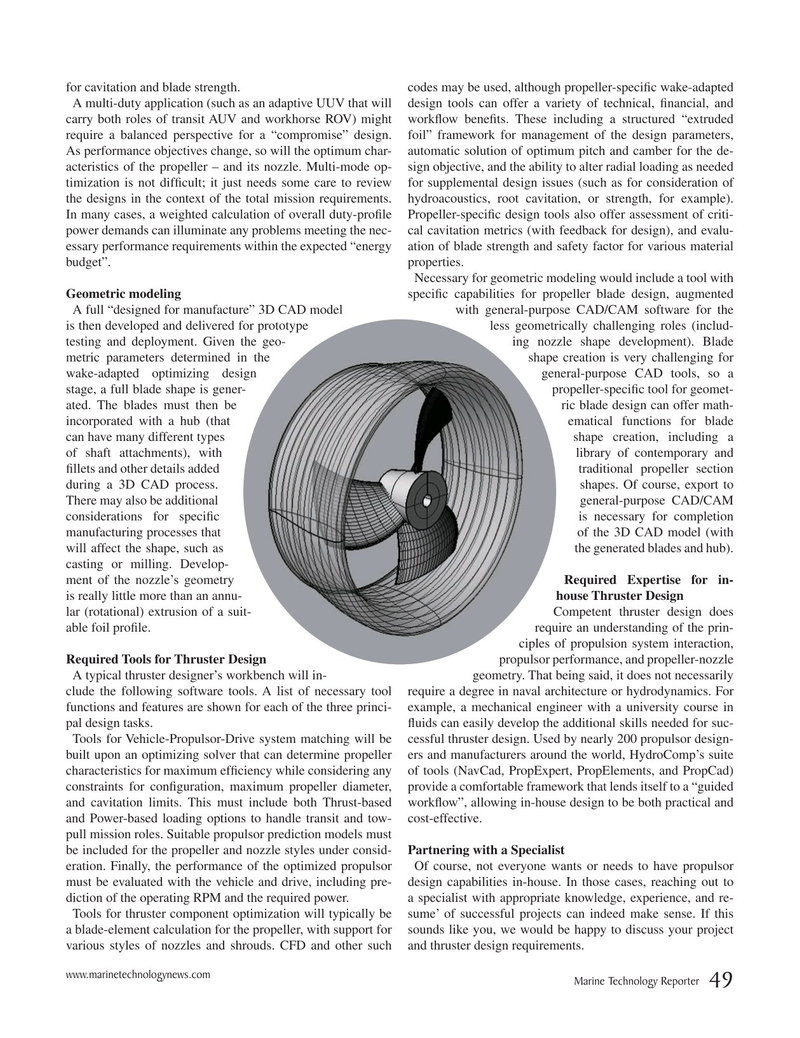
Page 49: of Marine Technology Magazine (September 2019)
Autonomous Vehicle Operations
Read this page in Pdf, Flash or Html5 edition of September 2019 Marine Technology Magazine
for cavitation and blade strength. codes may be used, although propeller-speci? c wake-adapted
A multi-duty application (such as an adaptive UUV that will design tools can offer a variety of technical, ? nancial, and carry both roles of transit AUV and workhorse ROV) might work? ow bene? ts. These including a structured “extruded require a balanced perspective for a “compromise” design. foil” framework for management of the design parameters,
As performance objectives change, so will the optimum char- automatic solution of optimum pitch and camber for the de- acteristics of the propeller – and its nozzle. Multi-mode op- sign objective, and the ability to alter radial loading as needed timization is not dif? cult; it just needs some care to review for supplemental design issues (such as for consideration of the designs in the context of the total mission requirements. hydroacoustics, root cavitation, or strength, for example).
In many cases, a weighted calculation of overall duty-pro? le Propeller-speci? c design tools also offer assessment of criti- power demands can illuminate any problems meeting the nec- cal cavitation metrics (with feedback for design), and evalu- essary performance requirements within the expected “energy ation of blade strength and safety factor for various material budget”. properties.
Necessary for geometric modeling would include a tool with
Geometric modeling speci? c capabilities for propeller blade design, augmented
A full “designed for manufacture” 3D CAD model with general-purpose CAD/CAM software for the is then developed and delivered for prototype less geometrically challenging roles (includ- testing and deployment. Given the geo- ing nozzle shape development). Blade metric parameters determined in the shape creation is very challenging for wake-adapted optimizing design general-purpose CAD tools, so a stage, a full blade shape is gener- propeller-speci? c tool for geomet- ated. The blades must then be ric blade design can offer math- incorporated with a hub (that ematical functions for blade can have many different types shape creation, including a of shaft attachments), with library of contemporary and ? llets and other details added traditional propeller section during a 3D CAD process. shapes. Of course, export to
There may also be additional general-purpose CAD/CAM considerations for speci? c is necessary for completion manufacturing processes that of the 3D CAD model (with will affect the shape, such as the generated blades and hub).
casting or milling. Develop- ment of the nozzle’s geometry Required Expertise for in- is really little more than an annu- house Thruster Design lar (rotational) extrusion of a suit- Competent thruster design does able foil pro? le. require an understanding of the prin- ciples of propulsion system interaction,
Required Tools for Thruster Design propulsor performance, and propeller-nozzle
A typical thruster designer’s workbench will in- geometry. That being said, it does not necessarily clude the following software tools. A list of necessary tool require a degree in naval architecture or hydrodynamics. For functions and features are shown for each of the three princi- example, a mechanical engineer with a university course in pal design tasks. ? uids can easily develop the additional skills needed for suc-
Tools for Vehicle-Propulsor-Drive system matching will be cessful thruster design. Used by nearly 200 propulsor design- built upon an optimizing solver that can determine propeller ers and manufacturers around the world, HydroComp’s suite characteristics for maximum ef? ciency while considering any of tools (NavCad, PropExpert, PropElements, and PropCad) constraints for con? guration, maximum propeller diameter, provide a comfortable framework that lends itself to a “guided and cavitation limits. This must include both Thrust-based work? ow”, allowing in-house design to be both practical and and Power-based loading options to handle transit and tow- cost-effective.
pull mission roles. Suitable propulsor prediction models must be included for the propeller and nozzle styles under consid- Partnering with a Specialist eration. Finally, the performance of the optimized propulsor Of course, not everyone wants or needs to have propulsor must be evaluated with the vehicle and drive, including pre- design capabilities in-house. In those cases, reaching out to diction of the operating RPM and the required power. a specialist with appropriate knowledge, experience, and re-
Tools for thruster component optimization will typically be sume’ of successful projects can indeed make sense. If this a blade-element calculation for the propeller, with support for sounds like you, we would be happy to discuss your project various styles of nozzles and shrouds. CFD and other such and thruster design requirements. www.marinetechnologynews.com
Marine Technology Reporter 49
MTR #7 (34-49).indd 49 9/4/2019 9:36:38 AM

 48
48

 50
50
